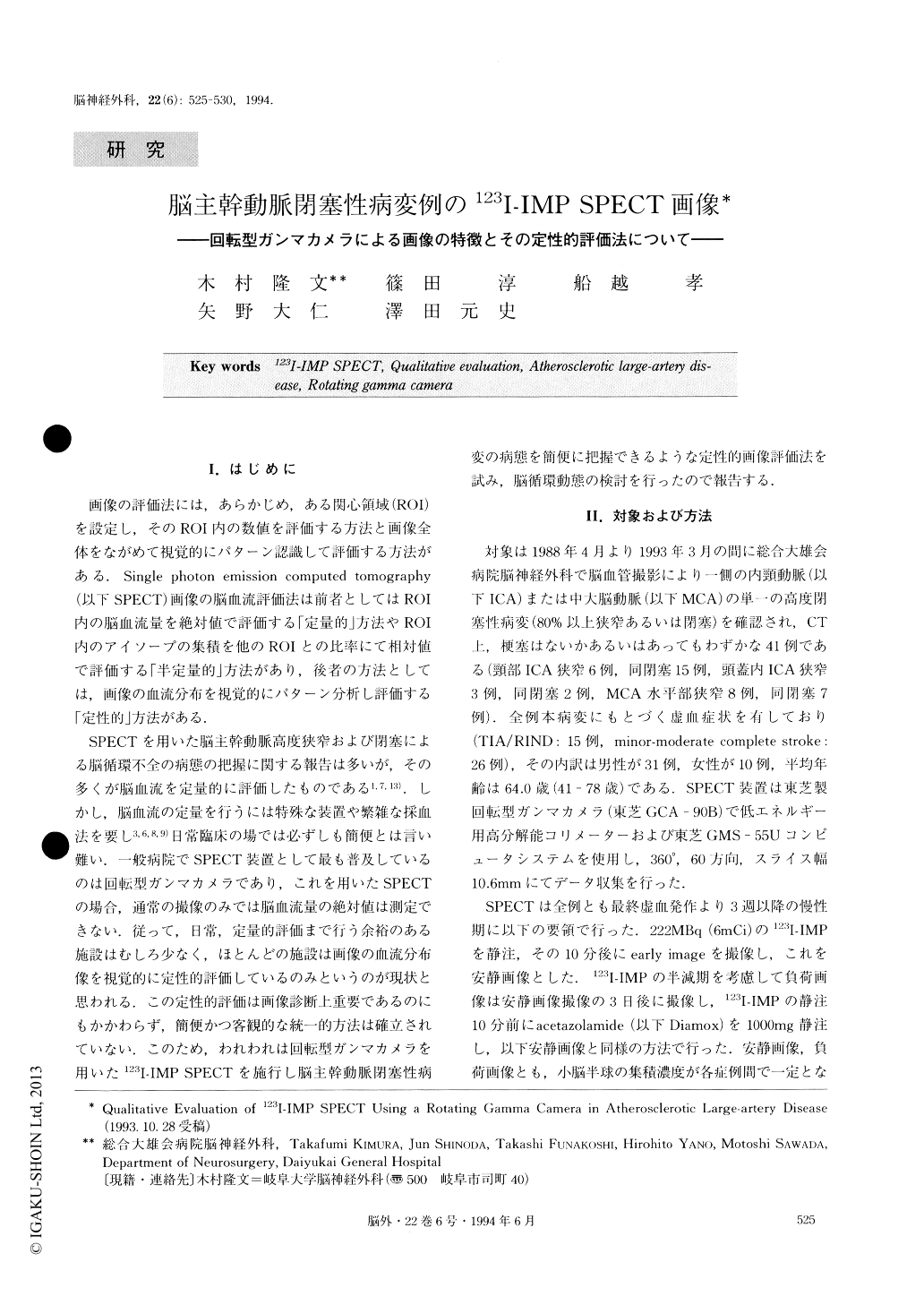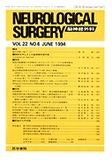Japanese
English
- 有料閲覧
- Abstract 文献概要
- 1ページ目 Look Inside
I.はじめに
画像の評価法には,あらかじめ,ある関心領域(ROI)を設定し,そのROI内の数値を評価する方法と画像全体をながめて視覚的にパターン認識して評価する方法がある.Single photon emission computed tomography(以下SPECT)画像の脳血流評価法は前者としてはROI内の脳血流量を絶対値で評価する「定量的」方法やROI内のアイソープの集積を他のROIとの比率にて相対値で評価する「半定量的」方法があり,後者の方法としては,画像の血流分布を視覚的にパターン分析し評価する「定性的」方法がある.
SPECTを用いた脳主幹動脈高度狭窄および閉塞による脳循環不全の病態の把握に関する報告は多いが,その多くが脳血流を定量的に評価したものである1,7,13).しかし,脳血流の定量を行うには特殊な装置や繁雑な採血法を要し3,6,8,9)日常臨床の場では必ずしも簡便とは言い難い.一般病院でSPECT装置として最も普及しているのは回転型ガンマカメラであり,これを用いたSPECTの場合,通常の撮像のみでは脳血流量の絶対値は測定できない.従って,日常,定量的評価まで行う余裕のある施設はむしろ少なく,ほとんどの施設は画像の血流分布像を視覚的に定性的評価しているのみというのが現状と思われる.この定性的評価は画像診断上重要であるのにもかかわらず,簡便かつ客観的な統一的方法は確立されていない.このため,われわれは回転型ガンマカメラを用いた123I-IHMP SPECTを施行し脳主幹動脈閉塞性病変の病態を簡便に把握できるような定性的画像評価法を試み,脳循環動態の検討を行ったので報告する.
Purpose Quantitative measurement of regional cere-bral blood flow (rCBF) needs special equipment or in-vasive blood sampling. Therefore, with a popularly used rotating gamma camera, we tried to establish a convenient modality of qualitative evaluation ofhemodynamics in patients with atherosclerotic large-artery disease, accroding to the distribution pattern of isotope-uptake on SPECT image.
Patients and Methods Forty-one patients with athero-sclerotic large-artery disease [9 internal carotid artery (ICA) stenosis, 17 ICA occlusion, 8 middle cerebral artery (MCA) stenosis, and 7 MCA occlusion] and 32 control patients documented as having small cerebral infarction without atherosclerotic large-artery disease were investigated. Using the rotating gamma camera, they underwent 123I-IMP SPECT at baseline and after acetazolamide loading. According to the distribution pattern of low isotope-uptake, early images were classi-fied into four types: Type I: no low uptake, Type Ⅱ: low uptake in a single watershed, Type Ⅲ: low up-take in two watersheds with or without a partial MCA territory, Type Ⅳ: low uptake in a whole MCA terri-tory.
Result In patients with large-artery disease, baseline images presented Type Ⅰ in 12 cases, Type Ⅱ in 16, Type Ⅲ in 9, Type Ⅳ in 4, and loading images Type Ⅰ in 3, Type Ⅱ in 2, Type Ⅲ in 8, Type Ⅳ in 28. Of 37 patients except for 4 belonging to Type Ⅳ at baseline, 32 (86.5%) had a more extensive low isotope-uptake area after acetazolamide loading than at baseline. In control patients, baseline images presented Type Ⅰin 25, Type Ⅱ in 7, and the Type Ⅲ & Ⅳ in 0, and the Type after loading was the same as the Type at baseline. Conclusion We established the qualitative evaluation of 123I-IMP SPECT image by detecting the “extent” of the ischemic region, taking notice of watershed. The pathognomonic findings on SPECT image of atherosc-lerotic large-artery disease showed that low isotope-uptake area at baseline extended into two watersheds or MCA territory by acetazolamide loading. The mod-ality of qualitative evaluation based on these patho-gnomic findings of SPECT image may be useful for easily assessing patients with atherosclerotic large-artery dis-ease using a rotating gamma camera.

Copyright © 1994, Igaku-Shoin Ltd. All rights reserved.


